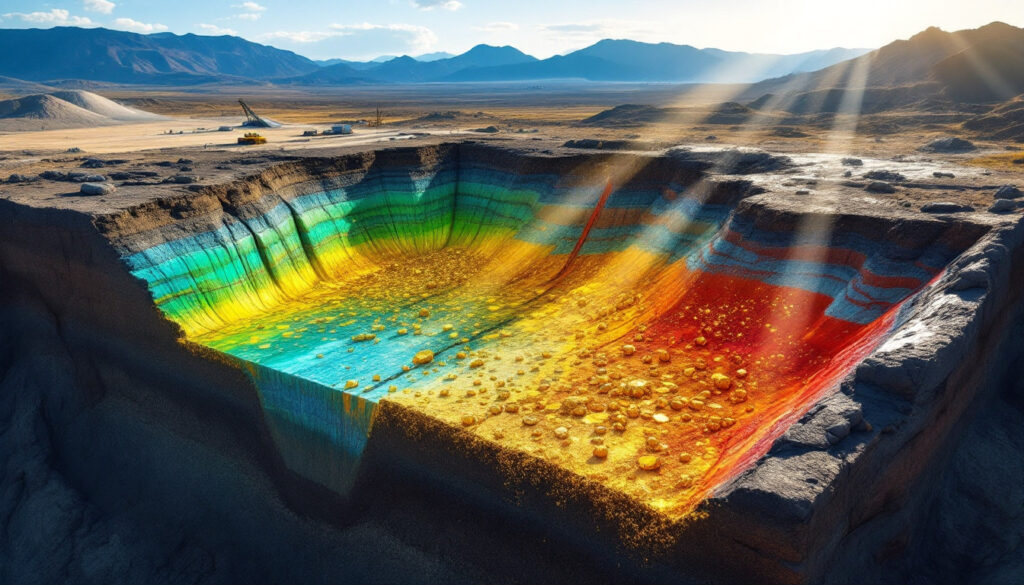What Are IOCG Deposits?
Iron oxide copper gold (IOCG) deposits represent one of the most economically significant mineral deposit types in modern mining. These remarkable geological formations host valuable concentrations of copper, gold, and uranium within iron oxide-dominated gangue assemblages that share a common genetic origin. Characterized by their impressive scale, IOCG deposits range from 10 million to over 4,000 million tonnes of contained ore, with copper grades typically between 0.2% and 5% and gold contents from 0.1 to 1.41 grams per tonne.
The worldwide average gold content across all IOCG deposits sits at approximately 0.41 g/t Au, with most deposits averaging less than 1 g/t Au. This may seem modest compared to dedicated gold deposits, but when coupled with substantial copper grades and potential uranium credits, these deposits become highly attractive mining targets.
IOCG deposits typically manifest in one of two morphologies: cone-like or blanket-like breccia sheets within granitic margins, or as ribbon-like breccias or massive iron oxide accumulations within fault or shear zones. Their tremendous size, relatively simple metallurgy, and comparatively high grades combine to create mining operations that often deliver exceptional profitability and multi-decade operational lifespans.
As Dr. Mark Hitzman, a pioneering researcher in IOCG deposits, noted, "These deposits represent metasomatic expressions of large crustal-scale alteration events driven by intrusive activity." This genetic relationship to large-scale geological processes explains both their substantial size and their tendency to occur in clusters or "provinces."
How Do IOCG Deposits Differ From Other Copper Deposits?
IOCG deposits stand apart from other large intrusive-related copper deposits such as porphyry copper systems through several distinctive characteristics. The most obvious difference lies in their substantial accumulations of iron oxide minerals (primarily hematite and magnetite), which form the dominant host rock for mineralization.
Unlike porphyry deposits, IOCG systems show a strong association with felsic-intermediate intrusive rocks, particularly sodium and calcium-rich granitoids. This association, first identified by Hitzman and colleagues in 1992, provides an important exploration indicator in prospective terranes.
Another key differentiator is the relative simplicity of IOCG deposits. They lack the complex concentric zonation patterns in alteration mineral assemblages that characterize porphyry systems, instead featuring a more straightforward copper-gold ± uranium ore assemblage. This simpler metallurgical profile often translates to lower processing costs in mining operations.
Groves et al. (2010) emphasized that IOCGs lack the wide metal spectrum (e.g., molybdenum, silver) commonly seen in porphyry systems, focusing instead on copper and gold with occasional uranium enrichment. This more focused metal suite often allows for higher-grade recovery of primary commodities.
The formation setting also differs significantly, with IOCGs forming at deeper crustal depths (typically exceeding 10km) compared to porphyry deposits that form in shallower crustal environments (less than 5km). This depth difference influences fluid chemistry, mineral precipitation mechanisms, and ultimately the deposit morphology.
Unlike porphyries, which form proximal to their source intrusion, IOCG deposits tend to accumulate within fault zones as epigenetic mineralization distal to the source intrusion. This spatial separation can make exploration more challenging but also creates opportunities for larger, more continuous ore bodies along structural corridors.
What Are The Key Features Of IOCG Deposits?
Geological Setting and Formation
IOCG deposits characteristically form within 'provinces' where several deposits of similar style occur in spatial and temporal proximity. The Gawler Craton in South Australia represents a classic example, hosting world-class deposits like Olympic Dam, Carrapateena, and Prominent Hill within a relatively confined geological domain.
These deposits consistently show association with major regional thermal events, often related to tectonic activity or mantle plume processes. The host stratigraphy typically exhibits relative iron enrichment (such as banded iron formations or ironstones) but contains minimal reduced carbon, which would otherwise inhibit the oxidation state necessary for IOCG formation.
One of the most remarkable aspects of IOCG provinces is the development of regional-scale alteration systems operating over tens or hundreds of kilometers. These extensive hydrothermal networks require large-scale crustal structures to facilitate fluid circulation, explaining the common association with major fault systems and crustal boundaries.
The temporal distribution of iron oxide copper gold ore deposits spans from 1.8 billion years ago to as recent as 15 million years ago, with most significant deposits clustering between 1.6 billion and 850 million years ago, coinciding with major episodes of continental assembly and breakup.
Ore Fluid Characteristics
The formation of IOCG deposits involves a complex interplay between two distinctive fluid types: highly oxidized fluids such as meteoric or ground waters, and brines derived from either magmatic hydrothermal processes or through reactions with metamorphic rocks.
Recent research by Schlegel et al. (2020) using fluorite rare-earth element tracers has provided compelling evidence for these mixed fluid sources at Olympic Dam, with implications for understanding mining drilling results in other regions. Their work demonstrates how fluid inclusion studies can unravel the complex history of ore formation.
The presence of volatile-rich fluids is increasingly recognized as crucial to deposit genesis. These fluids enhance metal transport efficiency and create the explosive brecciation textures common in many IOCG systems. The interaction between oxidized and reduced fluids at deposition sites triggers precipitation of both iron oxides and sulfide minerals.
Mineralogy and Alteration
The primary ore minerals in IOCG deposits are chalcopyrite and pyrite, typically comprising 10-15% of the rock mass. These sulfides occur within a gangue dominated by iron oxide minerals, with hematite prevailing in upper portions of deposits and magnetite becoming more prominent at depth.
Alteration styles in IOCG systems exhibit vertical zonation, ranging from deeper sodic-calcic assemblages (albite-epidote) to potassic assemblages (K-feldspar) in intermediate levels, with silica-K-feldspar-sericite dominating the upper portions of mineralized systems.
This alteration pattern creates a distinctive fingerprint that aids in exploration targeting, particularly when vectoring toward the core of a system from distal alteration zones. The transition from magnetite to hematite-dominated assemblages often coincides with zones of increased copper and gold grades.
What Economic Minerals Are Found In IOCG Deposits?
IOCG deposits host an economically significant suite of minerals that extends beyond their namesake elements. Copper mineralization, primarily as chalcopyrite, provides the economic backbone for most operations, with consistent grades between 0.7-1.5% Cu in world-class deposits.
Gold represents a critical value-adding component, appearing in various forms including native gold, electrum, or as gold-bismuth-antimony-tellurium alloys. As Zhu (2016) documented, gold content and mineral form heavily depend on redox conditions and host-rock chemistry, with higher grades typically associated with hematite-dominant assemblages.
Uranium mineralization forms a significant economic component in deposits like Olympic Dam, where 280 ppm U₃O₈ contributes substantially to the operation's profitability. This uranium content, while not universal across all IOCG systems, can transform marginal copper-gold operations into robust multi-commodity producers.
The iron oxide content itself can prove economically valuable when it trends toward magnetite or crystalline massive hematite. Deposits such as Wilcherry Hill, Cairn Hill, and Kiruna demonstrate that some IOCG systems can be economically viable based solely on their iron oxide contents, particularly in regions with established iron ore infrastructure.
Additional value comes from various trace elements, including bismuth and rare-earth elements. These by-products, though minor compared to the principal commodities, can provide significant revenue streams, especially as technology metals become increasingly important in clean energy applications.
The economic appeal of IOCG deposits stems from this multi-commodity nature, allowing mining operations to weather market fluctuations in any single metal through diversified revenue streams. This characteristic makes them particularly attractive investment targets in an increasingly volatile commodity market environment.
How Are IOCG Deposits Explored?
Exploration for Olympic Dam-style IOCG deposits typically relies on four principal criteria that guide targeting efforts across prospective terranes. The first criterion involves identifying substantial gravity anomalies, which represent the accumulation of dense iron oxide minerals characteristic of these deposits.
Complementing gravity surveys, magnetic data provides the second key indicator by highlighting areas of high magnetism within the crust, signaling substantial iron oxide mineral presence. The integration of gravity and magnetic datasets creates a powerful targeting tool for initial area selection.
The third critical factor is proximity to apparent crustal-scale linear features in geophysical data, reflecting the deep fault systems that facilitate fluid movement necessary for deposit formation. These structural corridors often host multiple deposits along their length, creating "strings of pearls" distribution patterns.
Finally, successful exploration programs target areas with prospective intrusive suites, such as the Hiltaba Granite Suite in Australia, which provides the thermal engine and potentially some of the metals and fluids necessary for IOCG formation.
In better-exposed terranes, field-based methods complement geophysical approaches, with prospecting for distinctive alteration assemblages and skarns providing direct evidence of hydrothermal activity. Geochemical exploration techniques, particularly multi-element soil surveys, help refine targets identified through broader geophysical methods.
Recent advances in innovations and digital transformation in mining have introduced 3D inversion modeling and machine learning applications that enhance anomaly detection and prioritization. These sophisticated tools allow explorers to identify subtle signatures of buried systems that might otherwise remain undiscovered using conventional methods.
Where Are The World's Major IOCG Deposits?
Australia
Australia hosts several world-class IOCG provinces, with the Gawler Craton in South Australia representing perhaps the most significant global endowment. Olympic Dam stands as the flagship deposit, containing a staggering 8,330 million tonnes of ore grading 0.8% Cu, 280 ppm U₃O₈, 0.76 g/t Au, and 3.95 g/t Ag.
The Olympic Dam deposit alone represents one of the world's largest resource inventories of copper, uranium, and gold, demonstrating the tremendous scale possible in IOCG systems. Nearby, the Carrapateena mine contains 203 Mt at 1.31% Cu and 0.56 g/t Au, while Prominent Hill Mine hosts 152.8 Mt at 1.18% Cu, 0.48 g/t Au, and 2.92 g/t Ag.
In Queensland's Cloncurry district, significant deposits include Mt. Elliott (475 Mt at 0.5% Cu, 0.3 g/t Au) and Ernest Henry (122 Mt at 1.18% Cu, 0.55 g/t Au). These deposits, while smaller than Olympic Dam, still represent world-class mineral endowments by any standard.
South America
Chile's Punta del Cobre IOCG province hosts several important deposits, including La Candelaria with resources of 600 Mt at 0.95% Cu, 0.2 g/t Au, and 3 g/t Ag. The Mantos Blancos deposit contains resources exceeding 500 Mt at 1.0% Cu, forming part of a significant metallogenic belt along the Andean margin.
Brazil's Para State IOCG province contains the Salobo Cu-Au deposit with reserves of 986 Mt at 0.82% Cu and 0.49 g/t Au, while the Sossego Cu-Au deposit holds 355 Mt at 1.1% Cu and 0.28 g/t Au. These Brazilian systems demonstrate the global distribution of the IOCG deposit type.
In Southern Peru, the Marcona IOCG district includes the Marcona Mine with 1,400 million tonnes of iron ore and Pampa de Pongo with 1,000 million tonnes of 75% magnetite. These iron-rich examples demonstrate how IOCG systems can transition to predominantly iron deposits while maintaining genetic links to more copper-rich counterparts.
While less explored, emerging IOCG provinces in Africa and Asia provide frontier opportunities for discovery. Recent exploration in Zambia, Namibia, and Kazakhstan has identified prospective terranes with geophysical signatures consistent with IOCG systems, suggesting the global endowment may be significantly larger than currently documented.
What Factors Control IOCG Deposit Formation?
The formation of iron oxide copper gold ore deposits remains one of economic geology's most debated topics, with several competing models proposed to explain their genesis. One prominent theory suggests IOCG deposits represent the lower root portion of iron oxide-apatite formations, linking these deposit types in a broader metallogenic system.
Another model emphasizes complex interactions between multiple fluids of varied origins. This hypothesis suggests that the mixing of magmatic, surficial, sedimentary, and metamorphic fluids creates the unique chemistry necessary for IOCG precipitation. The relative contributions of these different fluid sources likely vary between deposits, explaining some of the observed diversity in the deposit class.
Some researchers propose that deposit formation is driven by impacts to metasomatized lithospheric mantle through mantle underplating processes. This deep-earth model connects IOCG formation to fundamental plate tectonic processes and mantle dynamics, explaining their association with major crustal boundaries.
Recent advances in analytical techniques have opened new avenues for geological insights for mining exploration. Schlegel and colleagues (2020) demonstrated that fluorite rare-earth element chemistry can effectively identify fluid origins in the Olympic Dam deposit, providing a potential exploration tool for targeting large deposits elsewhere.
The ongoing debate about formation mechanisms reflects both the complexity of these systems and their economic importance. As one mining executive noted, "Understanding how these deposits form isn't just academic curiosity—it directly impacts our ability to find new resources and extend existing operations."
How Do IOCG Deposits Compare To Other Deposit Types?
IOCG deposits occupy a unique position in the spectrum of copper-bearing mineral systems, with characteristics that set them apart from other major deposit types. While some IOCG deposits show skarn-like affinities (such as Wilcherry Hill and Cairn Hill), they aren't strictly skarns, lacking the distinctive calc-silicate mineral assemblages and direct carbonate replacement textures.
The versatility of IOCG systems is evident in their varied expressions, from epithermal-like regimes near the surface to deeper brittle-ductile environments. This range of formation conditions creates diverse deposit morphologies, from massive replacement bodies to stockworks and breccias, sometimes within a single mineral system.
A key economic advantage of IOCG deposits is their typically higher copper grades compared to most world-class gold-rich porphyry copper deposits. While porphyries often grade between 0.3-0.8% Cu, many IOCG systems consistently deliver grades exceeding 1% Cu, significantly enhancing project economics.
The multi-commodity nature of IOCGs provides another competitive advantage, with copper, gold, uranium, and rare-earth elements often recovered from a single ore body. This commodity diversification reduces operational risk from price fluctuations in any single metal market.
Unlike VMS deposits, which form at or near ancient seafloors, IOCG systems develop in continental settings and typically contain lower levels of deleterious elements like arsenic and antimony. This cleaner metallurgical profile translates to fewer environmental challenges and often simpler understanding mineral separation techniques during processing.
FAQ About IOCG Deposits
What makes IOCG deposits economically significant?
IOCG deposits stand out economically due to their tremendous size, relatively simple metallurgy, and high grades of copper and gold. World-class deposits contain consistent copper grades between 0.7-1.5% Cu, significantly higher than the global average for copper mines. This grade advantage, combined with valuable by-products like gold and uranium, creates robust project economics even during periods of depressed metal prices.
The multi-commodity nature of these deposits serves as a natural hedge against market volatility, with strength in one metal market often offsetting weakness in another. Additionally, their typically massive scale allows for efficient bulk mining methods, driving down unit costs and supporting operational longevity measured in decades rather than years.
How do geologists identify potential IOCG deposits?
Identifying potential IOCG deposits begins with regional-scale geophysical surveys seeking coincident gravity and magnetic anomalies that indicate concentrated iron oxide mineralization. These surveys target areas near crustal-scale features and prospective intrusive suites, narrowing the search to the most favorable geological environments.
Once potential targets are identified, more detailed investigations employ a combination of additional geophysical methods (induced polarization, electromagnetic surveys), geochemical sampling, and targeted drilling to confirm the presence of mineralization. Advanced techniques now include hyperspectral core scanning to identify diagnostic alteration minerals and vector toward higher-grade zones.
The exploration process typically progresses from identifying regional provinces with IOCG potential to district-scale targeting of specific structural corridors, culminating in deposit-scale evaluation of individual mineral systems. Throughout this process, the integration of multiple datasets becomes critical to success, with machine learning algorithms increasingly employed to identify subtle patterns across
Ready to Spot the Next Major Mineral Discovery?
Stay ahead of the market with Discovery Alert's proprietary Discovery IQ model, providing instant notifications on significant ASX mineral discoveries like IOCG deposits. Visit our discoveries page to see how major mineral discoveries have historically generated substantial returns, and begin your 30-day free trial today.




